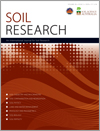SR19203Depletion, accumulation and availability of soil phosphorus in the Askov long-term field experiment
The use-efficiency of phosphorus (P) in agriculture is high on the agenda because rock phosphate used for production of mineral fertiliser is a scarce and non-renewable resource. The strong retention of fertiliser P in soil reduces its availability and challenges the P use-efficiency in crop production. This study documents the long-term response in plant-available P to scenarios where soil P depletes because P fertilisation is omitted or where it builds up because of surplus P input.





